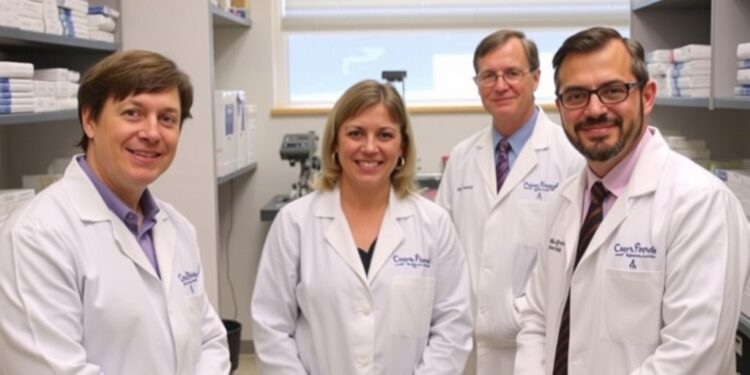In a groundbreaking study, researchers from Mass General Brigham have unveiled critical insights into the mechanisms underlying chemotherapy resistance in certain cancer types. While traditional cancer treatments have made significant strides in recent years, many tumors demonstrate an alarming ability to resist therapies, rendering them ineffective. This research addresses a crucial aspect of this challenge by focusing on the role of reactive oxygen species (ROS) in cancer cell death. The findings, detailed in a recent publication in Nature, highlight the influence of VPS35 mutations on ROS levels and their implications for treatment outcomes.
Reactive oxygen species, encompassing various free radicals and oxidants, are naturally produced during cellular metabolic processes. At low concentrations, ROS serve essential functions in signaling pathways that are vital for maintaining cellular health and function. However, elevated ROS levels can lead to significant cellular damage and are often linked to the development of various diseases, including cancer. Understanding the dual nature of ROS—both as agents of cell signaling and as potential contributors to cell death—is fundamental to deciphering the biology of cancer.
In this innovative study, the research team, led by Dr. Liron Bar-Peled and his colleagues, investigated how cancer cells manipulate ROS to survive chemotherapy treatments. Their analysis revealed that mutations in a key protein known as VPS35—integral to the cellular recycling process—can curb chemotherapy-induced apoptosis. This discovery is critical as it lays the groundwork for comprehending why some tumors resist treatment while others do not.
To elucidate the underlying mechanisms, the team employed experimental studies to scrutinize the ROS-sensing proteins within cancer cells. Their exhaustive screening identified several mutations that conferred increased resistance to chemotherapy. Among these, two specific mutations in VPS35 stood out, demonstrating a pivotal role in regulating intracellular ROS concentrations. Subsequent experiments confirmed that these VPS35 mutations resulted in decreased ROS levels, creating a less hostile environment for the cancer cells and allowing them to evade the cytotoxic effects of chemotherapeutic agents.
Beyond the laboratory, the researchers extended their investigation to clinical settings. They analyzed VPS35 expression in tumor samples from patients suffering from high-grade serous ovarian cancer (HGSOC), a particularly aggressive form of cancer. Notably, their findings indicated a correlation between elevated VPS35 levels and improved treatment responses, as well as enhanced overall survival rates. This connection underscores the potential of VPS35 as a prognostic biomarker in assessing tumor sensitivity to chemotherapy.
The implications of these findings extend beyond the immediate understanding of ROS dynamics within cancer cells. By pinpointing specific genetic alterations that contribute to treatment resistance, researchers may develop targeted therapies aimed at restoring the sensitivity of resistant tumors to established chemotherapy regimens. Such advancements hold the promise of significantly improving patient outcomes, particularly for those afflicted with recalcitrant cancer types.
As the scientific community continues to unravel the complexities of tumor biology, the insights provided by this study represent a significant step forward. The research highlights the critical interplay between mitochondrial function, ROS production, and the mechanisms of chemoresistance. Understanding these relationships is vital for developing new strategies in cancer treatment, ultimately aiming to reduce the prevalence of treatment-resistant tumors.
Furthermore, the focus on VPS35 as a potential therapeutic target opens avenues for novel interventions that could enhance the efficacy of existing chemotherapy and ultimately improve survival rates. As the field of oncology advances, embracing a more comprehensive understanding of the molecular players involved in cancer progression will be essential for developing tailored therapies that address individual patient needs.
In conclusion, the study conducted by Mass General Brigham researchers elucidates a crucial mechanism wherein VPS35 mutations influence ROS levels, contributing to chemotherapy resistance in cancer cells. The findings not only deepen our understanding of cancer biology but also pave the way for future therapeutic strategies aimed at overcoming treatment resistance. Such research endeavors will undoubtedly continue to shape the future of cancer treatment, offering hope to patients facing the challenges of aggressive tumors.
By bridging the gap between laboratory discoveries and clinical applications, researchers are one step closer to devising effective strategies that can reinvigorate the fight against cancer. This research emphasizes the importance of understanding the underlying cellular mechanisms contributing to cancer progression and treatment resistance. As ongoing studies further explore the intricate relationship between ROS and cancer cell survival, new opportunities will emerge to enhance therapeutic effectiveness and improve patient outcomes.
In summary, the implications of these discoveries extend beyond the immediate scientific community; they carry profound potential for future cancer therapies. By elucidating the role of VPS35 and ROS in chemotherapy resistance, the research not only contributes to advancing scientific knowledge but also holds promise for transforming therapeutic approaches for cancer patients worldwide.
Subject of Research: Reactive Oxygen Species and Chemotherapy Resistance in Cancer
Article Title: Understanding the Role of VPS35 in Chemoresistance: A Study of Reactive Oxygen Species
News Publication Date: 26-Mar-2025
Web References: Nature Article
References: DOI: 10.1038/s41586-025-08756-y
Image Credits: Mass General Brigham
Keywords: Cancer research, chemotherapy, ROS, VPS35, tumor resistance, mitochondrial function, apoptosis, ovarian cancer




